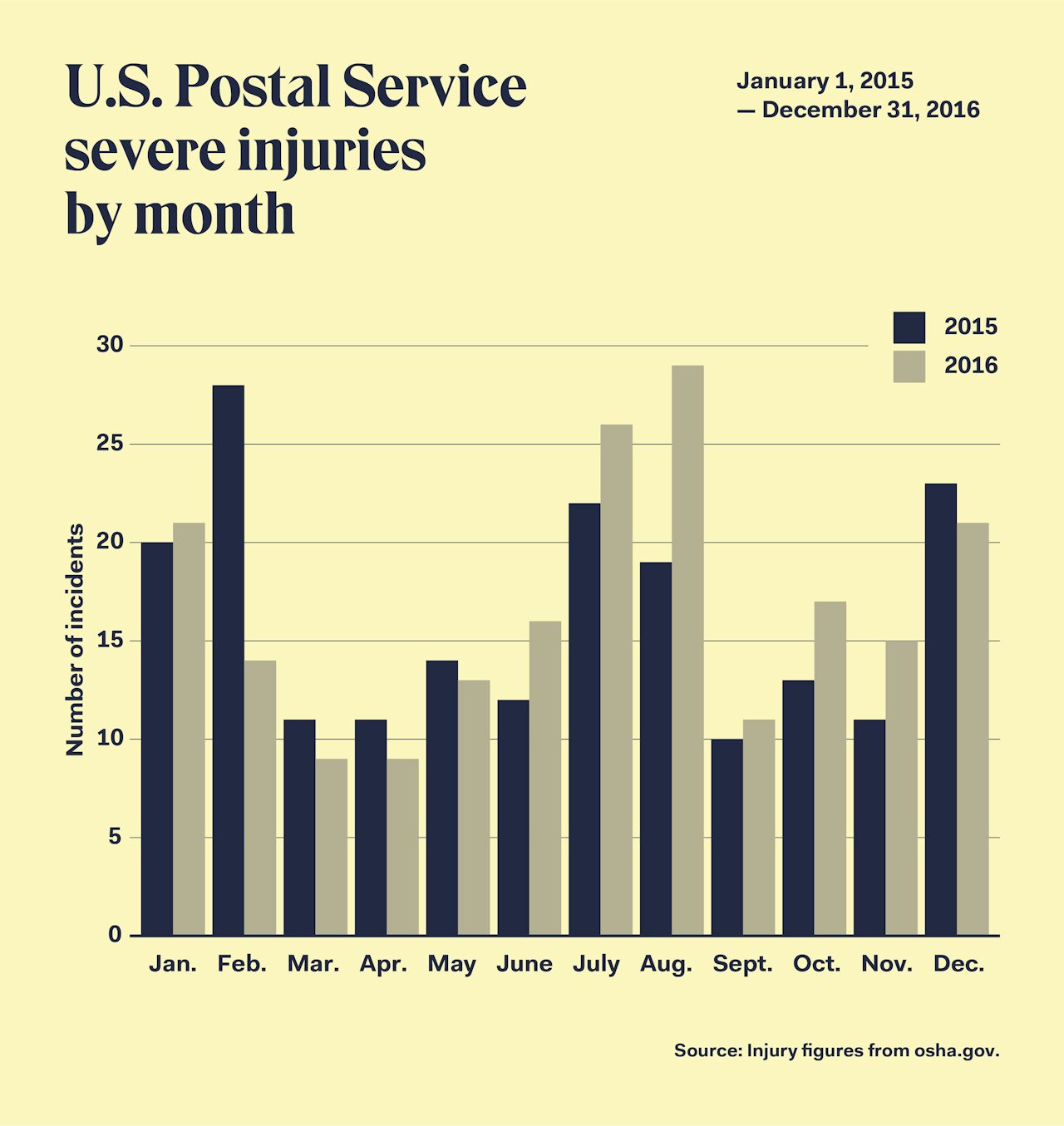Last summer, a postal worker in New Orleans was making a routine delivery in Bayou St. John, a neighborhood south of City Park. The postal worker walked up to the home and slid the mail through the slot on the door, like they’d done countless times before. But this time, a dog was on the other side. As the postal worker’s right hand entered the mail slot, the dog bit down and severed the employee’s index finger.
Such is life in one of America’s more common professions — and one of its more dangerous workplaces.
The Occupational Safety and Health Administration, or OSHA, has long required employers in the 29 states under its jurisdiction to report when a worker dies on the job. But in 2015, the agency began requiring employers to report when workers get “severely injured” to better identify dangerous workplaces and prevent future incidents. OSHA classifies an injury as “severe” when a worker suffers an amputation, the loss of an eye, or an injury that leads to the worker being hospitalized for at least one night. This data sheds new light on which jobs are more hazardous.
From the beginning of 2015 through the end of 2016, the United States Postal Service reported 395 severe injuries, the most of any employer. Behind it was Walmart, with 155 severe injuries and the United Parcel Service with 136. No other employer during that time period had more than 75.
The high numbers can be partly explained by the USPS’s gargantuan workforce. After all, the Postal Service is one of America’s largest employers with roughly 640,000 employees. But even after controlling for the number of employees, the USPS still looks bad — especially when compared to similar companies like UPS and FedEx. The chart below looks at severe injuries per 100,000 U.S. employees among companies with at least 30 incidents. The Postal Service ranks fourth on the list, just behind Waste Management and two poultry processing companies (JBS/Pilgrim’s Pride and Tyson Foods), all three of which belong to industries with reputations for unsafe workplaces and high risk of injury and fatality.
In a statement provided to The Outline, the USPS maintains that worker safety is of the utmost importance to the organization. “The mailing and shipping industry is not considered a dangerous industry,” the statement says. “Postal employees do not incur severe injuries in larger numbers than employees in industries with similar employee types and working conditions.”
Postal workers who suffer on the job injuries are entitled to workers’ compensation, which is administered by the Department of Labor. In Fiscal Year 2015, the U.S. Postal Service estimated its liability for future workers’ compensation costs at $18.8 Billion, up $389 Million from the previous year.
Another possible contributing factor in the high injury rates is the fact that the Postal Service has had a surge of new hires in recent years. The Postal Service added more than 117,000 non-career employees (temporary workers who do not receive the same benefits or privileges as career employees) in Fiscal Year 2015. At the same time, the organization failed to meet specific illness and injury frequency rates set by OSHA. In the Postal Service’s 2015 Annual Report to Congress, the authors wrote, “The failure to meet the actual target rate reflects major changes to the business and a significant increase in new employees who are more at risk for injury.”
Each incident report OSHA collects includes a short description of the events and the primary source of the injury. Postal carriers spend much of their time exposed to the elements and many of them pay the price for it. Heat-exhaustion and slipping on icy surfaces are some of the most common ways postal workers injure themselves, which explains the spike in incidents during the winter and summer months.
“A lot of the onus of avoiding injuries, at least on the street, is up to the carrier,” says Patrick, a rural postal carrier in southern New Mexico who asked that we not use his last name. Last week, the temperatures climbed over 105 degrees where Patrick delivers (meanwhile, in nearby Phoenix, Arizona, it was literally too hot for airplanes to take off), but aside from reminding employees to stay hydrated, Patrick says that the Postal Service expects him to look out for himself. “We have to provide our own water and food,” says Patrick. “We spring our own money for things like coolers and what not so that we can — or at least try to — have ice that lasts through the day.”
The data also reveals that dogs attacking mail carriers is more than just a cartoon trope. Domestic canines are the fourth most common source of severe injuries among postal workers.
“I liked dogs until I started working here,” says John, a 29-year-old mail carrier who works in Fitchburg, Massachusetts and also requested to have his last name withheld. Although he’s only been delivering mail for a few months, John says he’s already had multiple close calls with aggressive dogs, including an 80-lb. mutt that lunged at John and forced him to discharge his dog repellent spray. Fortunately, John hasn’t suffered any injuries while working and concedes that dealing with dogs is just part of the job. “Both my mom and dad are carriers,” he tells The Outline, “and if they can do it, so can I.”
“I liked dogs until I started working here.”
Although employers are required to file an incident report in the case of a severe injury, many don’t. In 2016, OSHA estimated that half of severe injuries go unreported — meaning this data may underestimate the danger of certain workplaces.
“Almost all occupational injuries are preventable,” says Debbie Berkowitz, a senior fellow at the National Employment Law Project, a nonprofit advocacy group in Washington, D.C. Berkowitz, a former senior policy advisor and chief of staff at OSHA, tells The Outline that it’s incumbent upon the Postal Service to provide safe conditions for their employees. Taking steps as simple as making sure postal carriers have enough water and allowing them to take time to rest during their delivery route can go a long way. “If you go to work everyday,” says Berkowitz. “Your employer is responsible for your health and safety.”
You won’t find the United States Postal Service on many lists of the most dangerous workplaces. But that’s because fatality rates are still commonly the only metric used to evaluate danger, which leads to an incomplete picture of the risks of certain jobs. But by looking at severe injuries, it’s now clear that one of America’s most visible professions is also one of its most vulnerable.
Note on methodology: This analysis reflects data from the 29 states that have adopted OSHA. The remaining states report incidents to their state governments, which administer their own health and safety programs. Larger companies with employees spread out across the U.S. or concentrated in those 29 states are more likely to be represented in the data. The data used in this analysis spans from January 1, 2015 through December 31, 2016 and includes more than 19,000 incidents from more than 10,000 employers — or 27 severe injuries a day.






